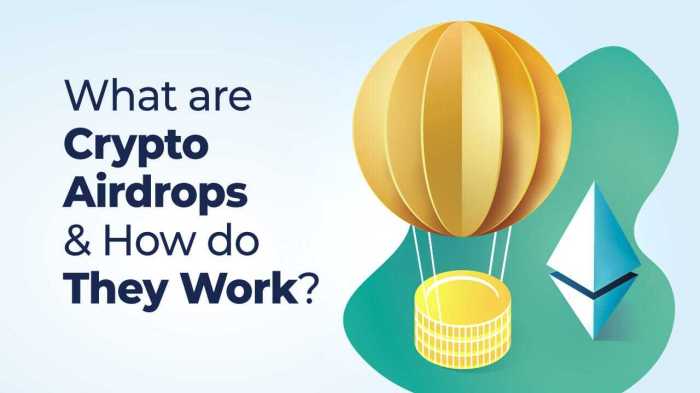Long-term potential of participating in Bitcoin airdrops is a topic gaining traction among cryptocurrency investors. While the allure of potentially lucrative rewards is undeniable, understanding the inherent risks is crucial. This exploration delves into the strategic aspects of airdrop participation, encompassing risk assessment, community engagement, and long-term portfolio management strategies, ultimately guiding investors toward informed decision-making in this volatile yet potentially rewarding landscape.
This analysis examines both the upside—the potential for significant returns from successful airdrops, illustrated with case studies of past successes—and the downside—the risks of scams, rug pulls, and market volatility. We provide a practical framework for identifying promising projects, navigating the technicalities of claiming airdrops, and incorporating them into a diversified investment portfolio. The long-term implications of holding versus selling airdropped tokens, including tax considerations, are also addressed.
Financial Risks and Rewards of Bitcoin Airdrops

Bitcoin airdrops, the distribution of cryptocurrency tokens to existing cryptocurrency holders, present a unique opportunity for significant financial gain but also carry substantial risks. While the potential for high returns is alluring, understanding the inherent dangers is crucial for informed participation. This analysis examines the potential rewards and the associated risks, providing a framework for safe and responsible engagement.
High-Return Potential of Successful Airdrops, Long-term potential of participating in Bitcoin airdrops
The allure of airdrops lies in the possibility of acquiring valuable cryptocurrency assets at little to no cost. Successful airdrops have yielded substantial returns for early participants. For example, the early adoption of Uniswap’s UNI token, distributed through an airdrop in 2020, resulted in significant gains for those who held Ethereum at the time. Similarly, the airdrop of the Optimism token (OP) in 2022 saw rapid price appreciation, rewarding those who participated.
These examples highlight the potential for exponential returns, but it’s crucial to remember that these are exceptions, and many airdrops fail to achieve similar success. The success of an airdrop depends heavily on factors such as the project’s underlying utility, market adoption, and overall team competency.
Risks Associated with Bitcoin Airdrops
The cryptocurrency market is inherently volatile, and airdrops are no exception. Several significant risks must be considered. Scams are prevalent, with fraudulent projects mimicking legitimate airdrops to steal user funds or personal information. Rug pulls, where developers abandon a project after raising funds, are another significant concern. Finally, the volatility of the cryptocurrency market means that even successful airdrops can experience dramatic price fluctuations, potentially eroding or eliminating gains.
Understanding these risks and mitigating them is paramount to successful participation.
Risk Profile Comparison of Different Airdrop Types
The risks associated with airdrops vary depending on several factors, including the project’s track record, the token’s utility, and the airdrop’s distribution method. The following table compares the risk profiles of different types of airdrops:
| Airdrop Type | Risk Level | Potential Reward | Example |
|---|---|---|---|
| Tokenized Airdrop (from established projects) | Medium | Medium to High | Optimism (OP) |
| NFT Airdrop | High | High (if the NFT gains value) | Airdrops of NFTs from established projects like BAYC |
| Airdrop from unknown projects | High | Low to High (highly speculative) | Many smaller, lesser-known projects |
| Airdrop requiring significant interaction (e.g., completing tasks) | Medium | Medium | Many projects require users to complete tasks on their platforms |
Safe Participation in Airdrops: A Step-by-Step Guide
Participating in airdrops requires a cautious and informed approach. A robust due diligence process is essential to minimize risks. Here’s a step-by-step guide:
- Verify the legitimacy of the project: Thoroughly research the project’s whitepaper, team, and online presence. Look for red flags such as unrealistic promises, anonymous team members, or a lack of transparency.
- Use a secure wallet: Employ a hardware wallet or a reputable software wallet with strong security measures to protect your cryptocurrency assets.
- Avoid suspicious links and websites: Only interact with official project websites and communication channels. Be wary of phishing scams and fraudulent websites.
- Never share your private keys: Protecting your private keys is paramount. Never share them with anyone, regardless of promises of rewards.
- Diversify your portfolio: Don’t invest a significant portion of your cryptocurrency holdings in a single airdrop.
- Understand the tokenomics: Carefully review the token’s utility, supply, and distribution mechanism.
Strategic Participation and Community Engagement

Active participation within the cryptocurrency community significantly increases the likelihood of securing valuable airdrops. Airdrops, often distributed to incentivize growth and engagement, are frequently targeted at users demonstrating a genuine interest and commitment to a project. This engagement goes beyond simply holding tokens; it involves actively participating in the project’s ecosystem.Engaging with a project’s community demonstrates commitment and increases visibility to the project team.
This active involvement can be the deciding factor in whether or not an individual receives an airdrop. A passive approach, by contrast, significantly reduces the chances of receiving these often lucrative rewards.
Identifying Promising Projects
Identifying projects poised to conduct airdrops requires diligent research and analysis. Successful identification relies on a multi-faceted approach encompassing several key indicators. Examining a project’s whitepaper provides crucial insights into its goals, tokenomics, and community engagement strategies. Simultaneously, monitoring social media activity, such as Twitter, Telegram, and Discord, reveals the level of community interest and developer responsiveness.
Analyzing the reputation and experience of the development team further assesses the project’s viability and potential for success. Projects with strong community engagement, clear roadmaps, and experienced developers are more likely to conduct airdrops to reward their loyal supporters.
Methods for Claiming Airdrops
Claiming airdrops involves various methods, each with specific technical requirements and potential challenges. Understanding these methods is crucial for successfully securing your rewards.
- Participating in community events: Many projects distribute airdrops as rewards for participation in activities such as completing tasks on platforms like Gitcoin, attending AMAs (Ask Me Anything sessions), or engaging in social media campaigns. Successful participation requires actively monitoring announcements and promptly completing the required tasks.
- Holding qualifying tokens: Some airdrops are distributed proportionally to users holding specific tokens. This requires identifying projects that announce airdrops to holders of certain tokens and ensuring you hold the necessary tokens within the specified timeframe.
- Using specific wallets or platforms: Some airdrops target users utilizing particular crypto wallets or decentralized applications (dApps). This requires understanding the wallet or platform compatibility requirements for the specific airdrop.
- Completing KYC (Know Your Customer) procedures: Certain projects may require KYC verification before distributing airdrops. This involves providing personal information for identity verification, which is crucial for compliance and security.
Challenges in claiming airdrops can include technical glitches on the project’s platform, missed deadlines, or difficulty navigating complex claiming processes.
Airdrop Participation Flowchart
The following flowchart visually represents the process of identifying, participating in, and managing airdrops.[Imagine a flowchart here. The flowchart would begin with “Identify Potential Projects” branching to “Analyze Whitepaper,” “Monitor Social Media,” and “Assess Developer Reputation.” These would all converge to “Evaluate Project Viability.” This would then branch to “Participate in Community Activities,” “Hold Qualifying Tokens,” “Use Specific Wallets/Platforms,” and “Complete KYC.” These would all converge to “Claim Airdrop.” Finally, this would branch to “Secure & Manage Airdrop” and “Track Portfolio.” ]
Long-Term Holding and Portfolio Management Strategies

The long-term viability of holding airdropped tokens versus immediate sale hinges on several factors, including the project’s underlying technology, market sentiment, and individual risk tolerance. Understanding these dynamics is crucial for crafting a successful cryptocurrency investment strategy that incorporates airdrops. This section will explore the nuances of long-term holding, tax implications, portfolio diversification, and provide a hypothetical example to illustrate potential outcomes.
Long-Term Holding Versus Immediate Sale
Holding airdropped tokens long-term offers the potential for significant returns if the project gains traction and its token value appreciates. However, this strategy carries inherent risk. The token’s value could plummet, resulting in substantial losses. Immediate sale eliminates this risk, providing immediate liquidity. The optimal strategy depends on individual risk tolerance and investment goals.
A conservative investor might opt for immediate sale, while a more aggressive investor might prefer to hold, accepting the higher risk for potentially greater reward. Historical examples of successful airdrops like Uniswap (UNI) show substantial gains for long-term holders, while others have seen their value diminish significantly.
Tax Implications of Airdropped Tokens
The tax implications of receiving and holding airdropped tokens vary significantly across jurisdictions. In some countries, airdrops are considered taxable income at the time of receipt, while others may have different rules based on the token’s value and the holder’s intention. It is crucial to consult with a qualified tax professional to understand the specific regulations in your region.
Failure to comply with tax laws can result in significant penalties. For example, in the United States, the IRS considers airdrops as taxable events, with the fair market value at the time of receipt determining the tax liability. This is subject to capital gains tax upon sale.
Incorporating Airdrops into a Diversified Cryptocurrency Portfolio
Airdrops should be incorporated into a diversified cryptocurrency portfolio strategically, considering overall risk tolerance and investment objectives. The allocation of airdropped tokens should be proportional to the overall portfolio’s risk profile. A more conservative portfolio might allocate a smaller percentage to airdrops, while a more aggressive portfolio could allocate a larger percentage. Diversification across different blockchain projects and token types is essential to mitigate risk.
Thorough due diligence on the project’s fundamentals, team, and technology is paramount before including any airdropped token in a portfolio.
Hypothetical Portfolio Example: Five-Year Projection
This hypothetical example illustrates a balanced approach to managing airdropped tokens over a five-year period. It is crucial to remember that this is a simplified model and actual returns may vary significantly. The example assumes a moderate risk tolerance and a diversified portfolio including established cryptocurrencies like Bitcoin and Ethereum alongside airdropped tokens.
| Year | Initial Investment | Airdrop Value | Total Portfolio Value |
|---|---|---|---|
| 1 | $10,000 | $1,000 | $11,500 |
| 2 | $10,000 | $1,500 | $13,200 |
| 3 | $10,000 | $2,000 | $15,000 |
| 4 | $10,000 | $1,000 | $16,000 |
| 5 | $10,000 | $500 | $17,500 |
Ending Remarks: Long-term Potential Of Participating In Bitcoin Airdrops
Successfully navigating the world of Bitcoin airdrops requires a blend of careful due diligence, active community engagement, and a well-defined long-term investment strategy. While the potential for substantial returns exists, understanding and mitigating the inherent risks is paramount. By adopting a strategic approach, investors can potentially harness the long-term value of airdrops, transforming them from fleeting opportunities into integral components of a robust cryptocurrency portfolio.
However, caution and a thorough understanding of the market remain essential for navigating this complex landscape successfully.
Frequently Asked Questions
What are the tax implications of receiving Bitcoin airdrops?
Tax implications vary significantly depending on your jurisdiction. Consult a tax professional to understand the specific rules in your region regarding the taxation of cryptocurrency gains and airdrops.
How can I identify legitimate airdrops and avoid scams?
Thoroughly research the project, verify its legitimacy through independent sources, and be wary of promises of guaranteed high returns. Avoid airdrops requiring excessive personal information.
What are the storage options for airdropped tokens?
Secure storage options include reputable hardware wallets or software wallets with robust security features. Never store large amounts of cryptocurrency on exchanges.
What if I receive an airdrop but don’t know how to claim it?
Many projects provide detailed instructions. Seek help from the project’s community or reputable online resources. If you are unsure, it’s often best to err on the side of caution and not claim the airdrop if the process seems unclear or risky.